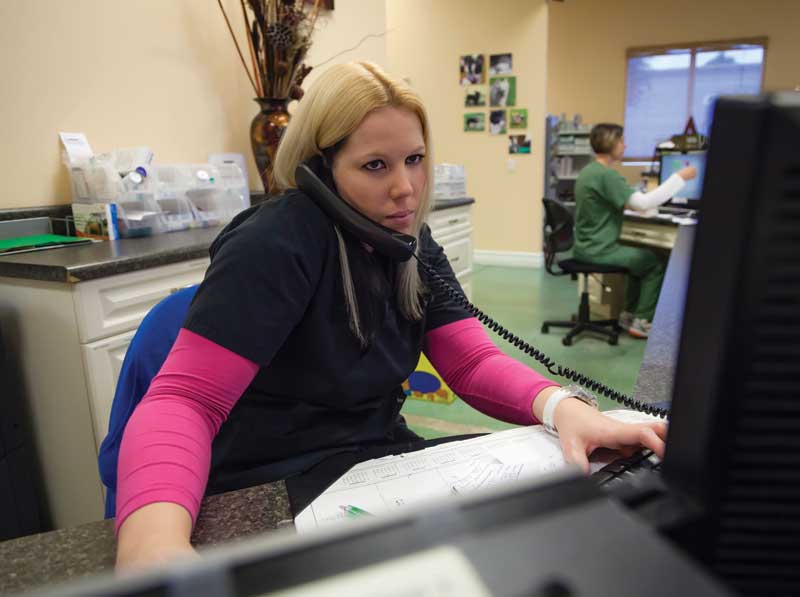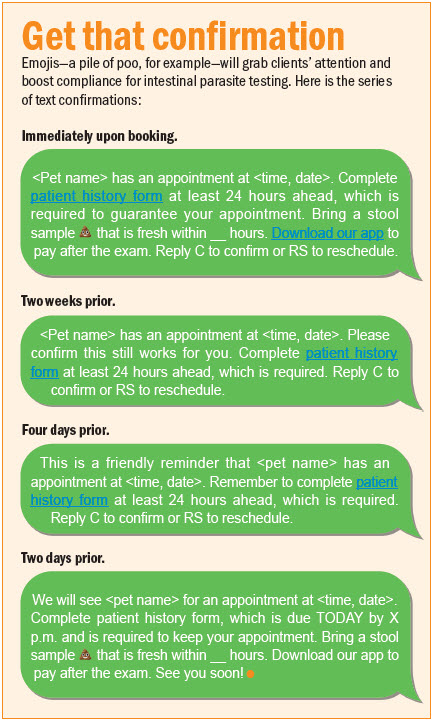
A practice manager told me her hospital does not have any checkups available for four months. Clients feel frustrated, and patients are not getting timely preventive care. If your practice is booking checkups two or more weeks out, you need to implement forward booking as a long-term solution.
Have clients schedule pets’ next checkups during today’s appointments. While dental practices aim to schedule 75 percent of patients in advance, only 11 percent of veterinary hospitals forward book six- or 12-month checkups.1,2 When clients schedule months in advance, you will have ample appointments available.
Here are four success factors to implement forward booking:
1) Pre-block checkups in your schedule template
Build your schedule 12 months out. Pre-block four checkups in each doctor’s daily schedule:
-
- First appointment of the day. Doctors are confident about preventive care, which creates a positive mindset for
the day. - Appointment before lunch. Because checkups are predictable and more likely to finish on time, the outpatient team can enjoy well-timed lunch breaks.
- Appointment after lunch. A checkup after lunch starts the afternoon on time.
- Last appointment of the day. Wrapping up the day with a checkup ensures the outpatient team goes home on time.
- First appointment of the day. Doctors are confident about preventive care, which creates a positive mindset for
Do not worry if veterinarians’ schedules change. Doctors will request time off in advance for vacation and conferences, especially if booking travel. Simply contact clients whose appointments need to be moved.
2) Have the outpatient team personally schedule future appointments
In dental practices, hygienists have greater success with pre-appointing patients than scheduling coordinators at checkout.1 By the time patients reach the checkout counter, they want to leave and may dismiss staff’s attempts to schedule.
Here is how to apply this strategy to checkups, pediatric exams, and progress exams:
-
- Checkups. Having technicians and assistants initiate conversations about future checkups emphasizes the importance of preventive medicine. Compare the pre-appointment strategy to dentists’ offices, which clients already experience. Use the yes-or-yes technique to lead pet owners to commit. Say, “Just as your dentist has you schedule your next appointment at checkout, we do the same to proactively manage your pet’s health. By scheduling today, you will get your first choice of doctor, day, and time. Do you prefer <date, time 1> or <date, time 2>?” The first choice is the same day of the week and time as today’s appointment. The second choice is a different day of the week and time of day (morning vs. afternoon).
When procrastinators will not commit, use benefit statements. Say, “I understand you don’t know your schedule 12 months from today. By scheduling now, you will get your first choice of doctor, day, and time. You will get a confirmation today and reminders as the date nears. If you need to change the appointment, just reply to the text/email. Does this same time and day typically work for you?” If the client agrees, recite the time and date out loud to reaffirm the decision. Say, “Fantastic, let’s schedule you for this same time on.”
If your hospital has computers in exam rooms, having outpatient teams schedule future appointments and collect payments is the most efficient. If clients will pay at the front desk, CSRs can use these same scripts. Always guide clients to pre-appoint before paying for today’s services because appointment reminders will print on receipts and trigger confirmations. Follow the best practice of “Schedule first, pay last.” - Pediatric exams. If you are booking three weeks out, puppies and kittens risk missing timely immunizations. During the first pediatric exam, forward book the remaining series of appointments. If a client visits today with an eight-week-old puppy, say, “Your puppy will need exams and vaccinations at 12 and 16 weeks of age. We need to provide timely exams to monitor ’s growth and development and vaccines for ongoing protection. We will schedule your puppy’s next two appointments today, so you will get your first choice of time, day, and doctor. Let’s set the next appointment when your puppy will be 12 weeks old. Do you prefer <date, time 1> or <date, time 2>?”
Once the client agrees, say, “Great, we will see on <date, time> for the 12-week-old appointment. Now let’s book the 16-week visit. Do you prefer <date, time 1> or <date, time 2>?” Let the client know to expect confirmations.
- Progress exams. If patients need progress exams, schedule today to ensure timely follow-up care. Seeing the same veterinarian builds client confidence that the medical problem will be resolved and supports exam efficiency. A different doctor will need more time to review the medical record to learn the previous veterinarian’s diagnosis and treatment.
Use words that work. Replace the wiggle word of “recommend” with the action word of “needs.” “Progress exam” communicates that follow-up care is medically necessary, and you are moving forward in resolving the health concern. “Recheck” may be perceived as free and optional. Say, “Dr. needs to see in two weeks for a progress exam for the ear infection. Do you prefer <date, time 1> or <date, time 2>?”
- Checkups. Having technicians and assistants initiate conversations about future checkups emphasizes the importance of preventive medicine. Compare the pre-appointment strategy to dentists’ offices, which clients already experience. Use the yes-or-yes technique to lead pet owners to commit. Say, “Just as your dentist has you schedule your next appointment at checkout, we do the same to proactively manage your pet’s health. By scheduling today, you will get your first choice of doctor, day, and time. Do you prefer <date, time 1> or <date, time 2>?” The first choice is the same day of the week and time as today’s appointment. The second choice is a different day of the week and time of day (morning vs. afternoon).
3) Implement a confirmation protocol
Dentists found patients who leave with appointments are statically more likely to show up.3 Only 10 percent of dental patients cancel or no-show.
Forward booking saves clients future tasks and makes preventive care easier. Veterinary hospitals experience 11 percent no-shows.4 Text and email confirmations significantly lessen cancellations and no-shows.
Confirmations should include hyperlinks to online forms based on the reason for visit. Use emojis to increase open rates and clients’ understanding of appointment instructions (See: “Get that confirmation”).
If clients have not confirmed or submitted online forms two days prior, call them. Say, “We have reserved an appointment for at <time, date>. We are experiencing increased appointment requests and have other patients on a wait list. We need your confirmation and online form submitted by X p.m. today or ’s appointment will be released to another patient in need. Please text/email/call us with questions.”
Should clients fail to respond, call them after your deadline and send backup texts or emails to inform them that their appointments have been cancelled. Text: “We regret we have not received your confirmation and/or online form, which is required to guarantee your pet’s exam. Your appointment on <date, time> has been released to another patient in need. Book online or download our app to reschedule.”
4) Make having future appointments the norm
Dentists do not give patients a choice. Their pre-appointing strategy has been successful for decades. Veterinary practices can implement forward booking to ensure timely preventive care, future hospital revenue, and fewer scheduling phone calls.
| Check out the author’s online course, “Everything You Need to Know About Scheduling” for tips on sending confirmations with actions that improve practice efficiency: https://csvets.info/scheduling. |
Wendy S. Myers, CVJ, has taught communication and client service skills for more than two decades. As founder of Communication Solutions for Veterinarians, she teaches practical skills through online courses, onsite coaching, and conferences. Myers was a partner in an AAHA-accredited specialty and emergency practice. Visit Csvetscourses.com to learn more.
References
- Faustino A. How to Improve Dental Recall with These Tips. Available at: https://capforge.com/how-to-improve-dental-recall-with-these-tips/. Accessed Feb 6, 2024.
- Forward Booking: How Forward Booking Leads to Better Patient Care. AAHA and Partners for Healthy Pets. Available at: https://www.aaha.org/globalassets/04-practice-resources/Forward-booking. Accessed Feb 6, 2024.
- 6 Metrics That Determine the Success of Your Dental Practice. ThriveCloud. Available at: https://mythrivecloud.com/6-metrics-that-determine-success-dental-practice/. Accessed Feb 6, 2024.
- What Pesky No-Shows Actually Cost Your Veterinary Practice. PetDesk. Availabe at: https://petdesk.com/blog/what-pesky-no-shows-actually-cost-your-veterinary-practice/. Accessed Feb 6, 2024.

